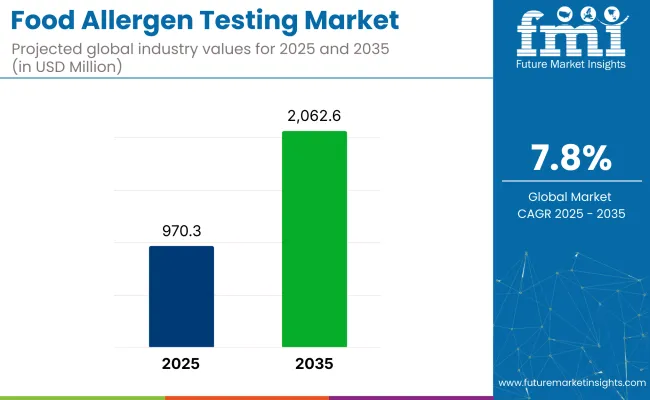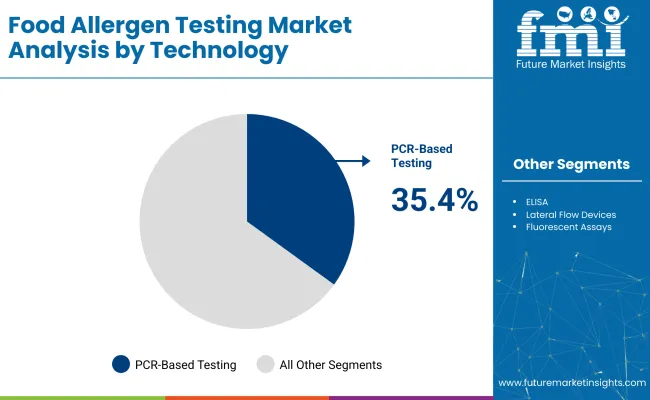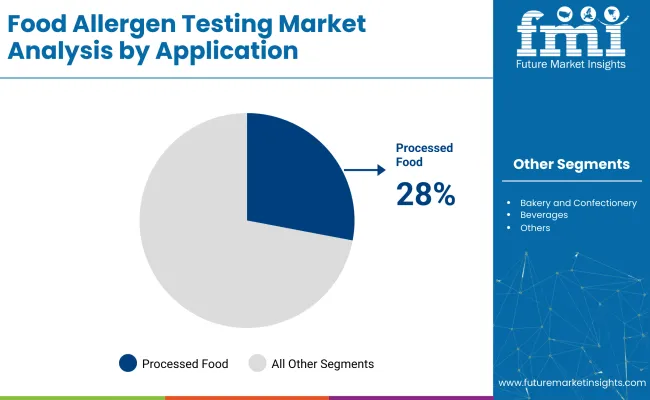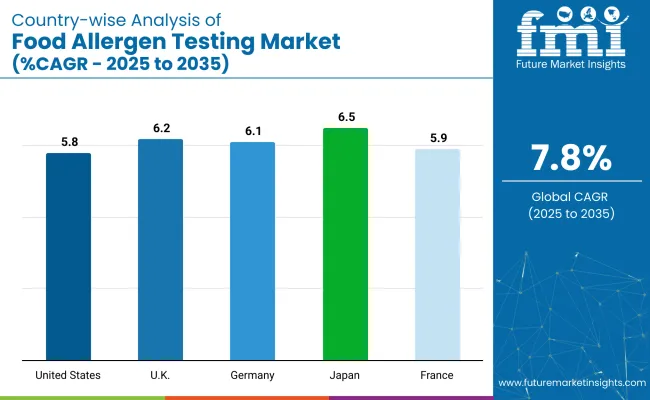The global food allergen testing market is valued at USD 970.3 million in 2025 and is slated to reach USD 2,062.6 million by 2035, reflecting a CAGR of 7.8%.

| Metric | Value |
|---|---|
| 2025 Market Value | USD 970.3 million |
| 2035 Market Value | USD 2,062.6 million |
| CAGR (2025 to 2035) | 7.8% |
This growth is being driven by increasing consumer health awareness, the rising prevalence of food allergies, and stringent food safety regulations that mandate allergen labeling across regions. Additionally, the expanding packaged and processed food sector, coupled with innovations in multiplex allergen testing and AI-based analysis, is expected to fuel market demand over the forecast period.
Japan is projected to grow at a CAGR of 6.5% from 2025 to 2035, driven by rising seafood and wheat allergies and strict labelling regulations. The UK is expected to record a 6.2% CAGR, supported by consumer demand for allergen labelling and Natasha’s Law enforcement.
Germany will grow at a 6.1% CAGR due to strict EU food safety standards and high allergy prevalence. PCR-based testing is expected to lead the technology segment with a 35.4% share, while processed food remains the dominant application segment, holding a 28% market share in 2025.
The food allergen testing market holds a 10-15% share within the broader food safety testing market, reflecting its growing importance in ensuring consumer safety against allergenic risks. Within the food diagnostics market, it accounts for around 8-10%, driven by the rising demand for specialised allergen detection technologies.
In the overall food testing and inspection market, its share is estimated at 5-7%, as microbial, chemical, and nutritional testing dominate this segment. However, the market’s share is expected to increase steadily due to stringent regulations, the rising prevalence of food allergies, and growing investments by manufacturers in allergen-specific testing to ensure compliance and maintain consumer trust.
The food allergen testing market is segmented by source, technology, application, and region. By source, the market includes milk, eggs, fish, tree nuts, peanuts, wheat, soybeans, sesame, shellfish, and others (lupin, casein, mustard, celery, molluscs, sulphites, buckwheat). Based on technology, it is segmented into polymerase chain reaction (PCR), enzyme-linked immunosorbent assay (ELISA), lateral flow devices (LFD), high-performance liquid chromatography (HPLC), and fluorescent assays.
By application, the market includes bakery and confectionery, processed food, infant formula and baby food, beverages, meat and seafood, dairy products, and others (sauces and dressings, ready-to-eat meals, snacks, spices and seasonings, food ingredients and additives). Regionally, the market is segmented into North America, Latin America, Western Europe, Eastern Europe, Balkans & Baltic, Russia & Belarus, Central Asia, East Asia, South Asia & Pacific, and the Middle East & Africa.
Milk has emerged as the most lucrative segment in the food allergen testing market and is expected to hold approximately 25% share in 2025.
Polymerase Chain Reaction (PCR) is the most lucrative technology segment, and is projected to account for 35.4% market share in 2025.

Processed food is the most lucrative application segment, accounting for approximately 28% of the market share in 2025.

The global food allergen testing market is growing steadily, driven by rising food allergy cases, increasing consumer demand for allergen-free products, and advancements in testing technologies, including PCR, ELISA, and multiplex assays.
Recent Trends in the Food Allergen Testing Market
Challenges in the Food Allergen Testing Market

Japan is projected to record the highest CAGR among these countries, at 6.5% from 2025 to 2035, driven by rising seafood and wheat allergies, as well as strict labeling regulations. The United Kingdom follows closely with a 6.2% CAGR.
Germany is expected to grow at a 6.1% CAGR due to strict EU food safety standards and a high prevalence of allergies. France shows slightly lower growth at a 5.9% CAGR, while the United States records the weakest among them at a 5.8% CAGR, despite having strong regulatory frameworks and high allergy rates.
The report covers an in-depth analysis of 40+ countries; five top-performing OECD countries are highlighted below.
The USA food allergen testing market is projected to grow at a CAGR of 5.8% from 2025 to 2035.
UK food allergen testing revenue is expected to grow at a CAGR of 6.2% from 2025 to 2035.
Germany’s food allergen testing demand is anticipated to grow at a CAGR of 6.1% from 2025 to 2035.
Sales of food allergen testing products in France are forecasted to expand at a CAGR of 5.9% from 2025 to 2035.
Sales of food allergen testing products in Japan are projected to register a CAGR of 6.5% from 2025 to 2035.
The food allergen testing market is moderately consolidated, with a few large multinational companies dominating global operations while several regional players serve niche markets. Leading companies compete primarily through technological innovation, service expansions, acquisitions, and strategic partnerships to strengthen their portfolios and global presence.
Top players, including Eurofins Scientific, SGS S.A., Intertek Group plc, Bureau Veritas, and Neogen Corporation, focus on expanding their testing capabilities by adopting advanced technologies such as PCR, ELISA, and multiplex assays. These companies maintain competitive pricing structures for routine testing services while investing significantly in R&D to develop sensitive, rapid, and accurate allergen detection solutions that comply with stringent food safety regulations worldwide.
Recent Food Allergen Testing Industry News
| Report Attributes | Details |
|---|---|
| Current Total Market Size (2025) | USD 970.3 million |
| Projected Market Size (2035) | USD 2,062.6 million |
| CAGR (2025 to 2035) | 7.8% |
| Base Year for Estimation | 2024 |
| Historical Period | 2020 to 2024 |
| Projections Period | 2025 to 2035 |
| Market Analysis Parameters | Revenue in USD million/Volume (Units) |
| By Source | Milk, Eggs, Fish, Tree Nuts, Peanuts, Wheat, Soybean, Sesame, Shellfish, Others (Lupin, Casein, etc.) |
| By Technology | Polymerase Chain Reaction (PCR), Enzyme-Linked Immunosorbent Assay (ELISA), Lateral Flow Devices (LFD), High-Performance Liquid Chromatography (HPLC), Fluorescent Assays |
| By Application | Bakery and Confectionery, Processed Food, Infant Formula and Baby Food, Beverages, Meat and Seafood, Dairy Products, Others (Sauces and Dressings, Ready-to-Eat Meals, Spices and Seasonings, and Food Ingredients and Additives) |
| Regions Covered | North America, Latin America, Western Europe, Eastern Europe, East Asia, South Asia & Pacific, Middle East & Africa |
| Countries Covered | United States, Canada, United Kingdom, Germany, France, China, Japan, South Korea, Brazil, Australia |
| Key Players | Eurofins Scientific, SGS S.A., Intertek Group plc, Bureau Veritas, Neogen Corporation, ALS Limited, Mérieux NutriSciences Corporation, TÜV SÜD, Microbac Laboratories, Inc., Romer Labs Diagnostic GmbH, Symbio Laboratories, Charm Sciences, Inc., R-Biopharm AG, ELISA Technologies, Inc., VWR International, LLC. |
| Additional Attributes | Dollar sales by value, market share analysis by region, and country-wise analysis |
As per Source, the industry has been categorized into Milk, Eggs, Fish, Tree nuts, Peanuts, Wheat, Soybean, Sesame, Shellfish, and Others (Lupin, Caesin, etc.).
As per Technology, the industry has been categorized into Polymerase Chain Reaction (PCR), Enzyme-Linked Immunosorbent Assay (ELISA), Lateral Flow Devices (LFD), High-Performance Liquid Chromatography (HPLC), and Fluorescent Assay.
As per Application, the industry has been categorized into Bakery and Confectionery, Processed Food, Infant Formula and Baby Food, Beverages, Meat and Seafood, Dairy Products, and Others.
Industry analysis has been carried out in key countries of North America, Latin America, Western Europe, Eastern Europe, East Asia, South Asia & Pacific, Central Asia, Russia & Belarus, Balkan & Baltics, and the Middle East & Africa.
The market is valued at USD 970.3 million in 2025.
It is projected to reach USD 2,062.6 million by 2035.
Polymerase chain reaction (PCR) leads with a 35.4% market share.
The market is expected to grow at a CAGR of 7.8% from 2025 to 2035.
Japan is projected to hold a CAGR of 6.5% from 2025 to 2035.






Full Research Suite comprises of:
Market outlook & trends analysis
Interviews & case studies
Strategic recommendations
Vendor profiles & capabilities analysis
5-year forecasts
8 regions and 60+ country-level data splits
Market segment data splits
12 months of continuous data updates
DELIVERED AS:
PDF EXCEL ONLINE
Food & Beverage OEE Software Market Size and Share Forecast Outlook 2025 to 2035
Food Grade Crosslinked Polyvinylpolypyrrolidone (PVPP) Market Size and Share Forecast Outlook 2025 to 2035
Food Grade Cassia Gum Powder Market Size and Share Forecast Outlook 2025 to 2035
Food Grade Dry Film Lubricant Market Size and Share Forecast Outlook 2025 to 2035
Foodservice Equipment Market Analysis - Size, Share, and Forecast Outlook 2025 to 2035
Food Basket Market Forecast and Outlook 2025 to 2035
Food Grade Tremella Polysaccharide Market Size and Share Forecast Outlook 2025 to 2035
Food Sorting Machine Market Size and Share Forecast Outlook 2025 to 2035
Foodservice Paper Bag Market Size and Share Forecast Outlook 2025 to 2035
Food Stabilizers Market Size and Share Forecast Outlook 2025 to 2035
Food Packaging Film Market Size and Share Forecast Outlook 2025 to 2035
Food Certification Market Size and Share Forecast Outlook 2025 to 2035
Food Tray Market Size and Share Forecast Outlook 2025 to 2035
Food & Beverage Industrial Disinfection and Cleaning Market Size and Share Forecast Outlook 2025 to 2035
Food Technology Market Size and Share Forecast Outlook 2025 to 2035
Food Tourism Sector Market Size and Share Forecast Outlook 2025 to 2035
Food Processing Boiler Market Size and Share Forecast Outlook 2025 to 2035
Food Packaging Machines Market Size and Share Forecast Outlook 2025 to 2035
Food Minerals Market Size and Share Forecast Outlook 2025 to 2035
Food And Beverage Chemicals Market Size and Share Forecast Outlook 2025 to 2035

Thank you!
You will receive an email from our Business Development Manager. Please be sure to check your SPAM/JUNK folder too.
Chat With
MaRIA